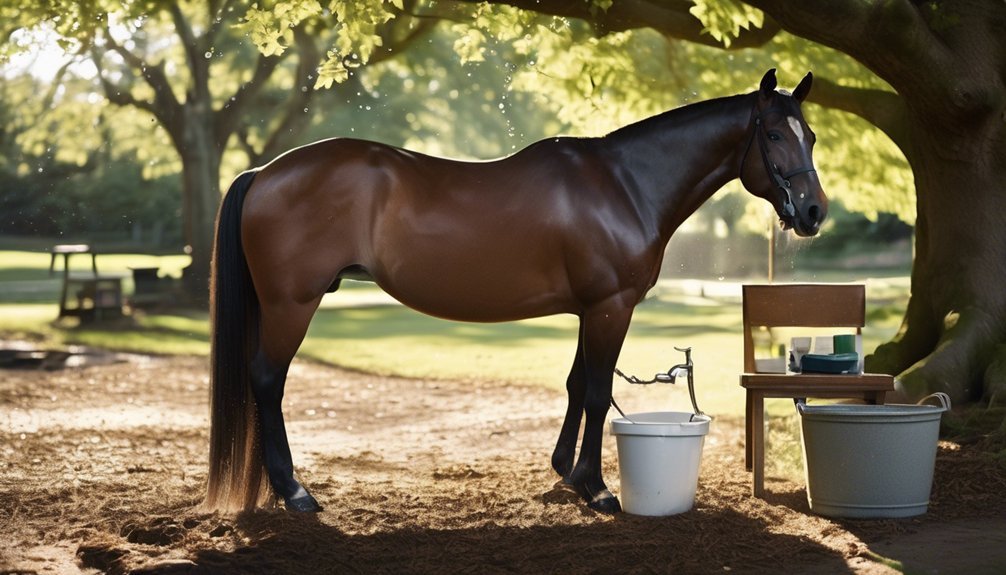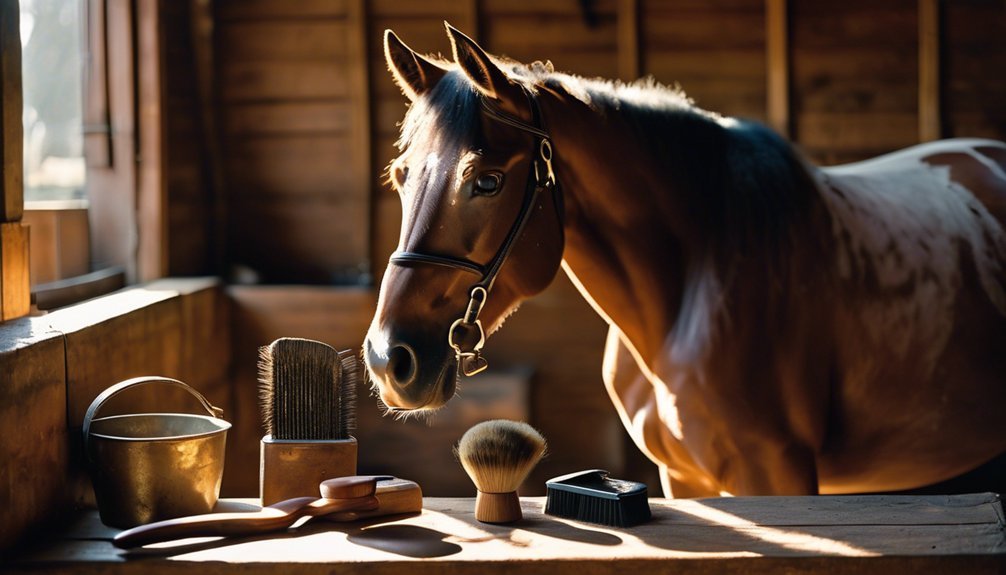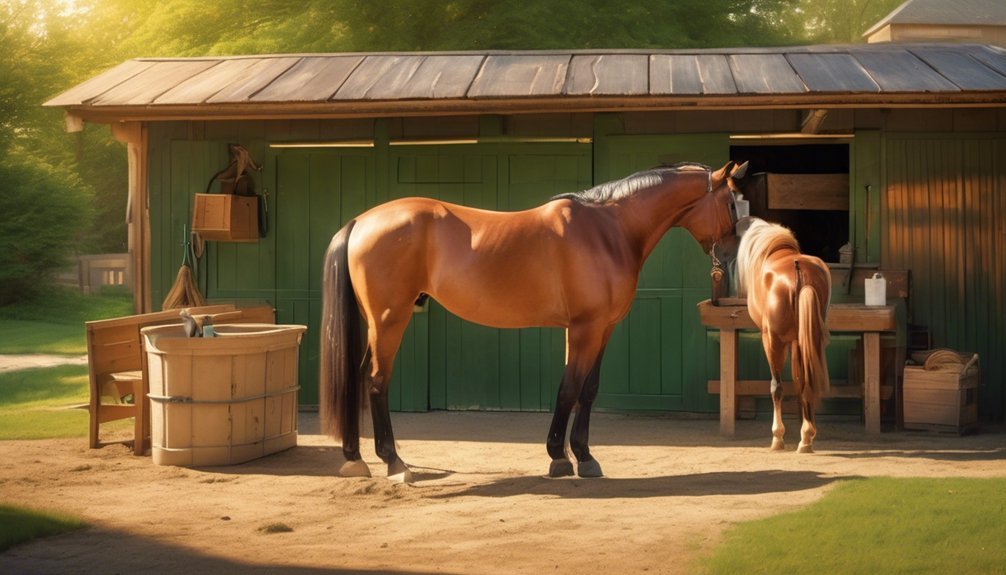
Maintaining your horse's coat during hot weather is crucial for their health and comfort. You need to focus on hydration, regular grooming, and sun protection to keep their coat in top condition. Ignoring these aspects can lead to skin issues and discomfort. Understanding the right techniques and tools can make all the difference. Let's explore the essential steps to ensure your horse stays cool and their coat remains healthy throughout the summer months.
Key Takeaways
- Provide ample shade and ventilation to protect your horse from direct sunlight and heat buildup in stables.
- Ensure your horse stays hydrated by providing clean, cool water and considering electrolytes after exercise.
- Maintain a regular grooming routine to remove dirt and sweat, enhancing comfort and coat health.
- Apply equine sunscreen to sensitive areas to prevent sunburn and protect the coat from UV damage.
- Schedule regular veterinary check-ups and monitor for signs of irritation or behavioral changes in hot weather.
Understanding the Importance of Coat Health

When you consider your horse's overall well-being, coat health often plays a crucial role in their appearance and comfort. A shiny, well-maintained coat not only enhances your horse's beauty but also reflects their internal health.
Proper coat maintenance involves a balanced diet rich in essential fatty acids and vitamins, which support skin and fur vitality. Regular grooming helps distribute natural oils, promoting a lustrous coat appearance while also serving to check for irritations or parasites.
You'll want to pay attention to seasonal changes, as they can impact coat quality. Investing time in understanding your horse's unique needs will ensure their coat remains healthy and vibrant, contributing to their overall happiness and your bond.
Regular Grooming Routines
Regular grooming is a vital part of maintaining your horse's coat and overall health. Establishing a consistent grooming routine helps to remove dirt, sweat, and loose hair, ensuring your horse stays comfortable during hot weather.
Aim for a grooming frequency of at least three to four times a week. Here are some effective brushing techniques to incorporate into your routine:
- Start with a curry comb to loosen dirt and debris, working in circular motions.
- Follow with a stiff brush to remove the loosened dirt and hair, using firm strokes in the direction of hair growth.
- Finish with a soft brush to bring out the shine and remove any remaining dust.
These steps not only promote a healthy coat but also strengthen your bond with your horse.
Choosing the Right Grooming Tools

Selecting the right grooming tools is essential for maintaining your horse's coat and ensuring a smooth grooming experience. Invest in quality grooming brushes that suit your horse's coat type. Soft brushes work well for sensitive areas, while stiffer ones help remove dirt and debris. Don't forget coat conditioners; they enhance shine and protect against the sun.
| Tool Type | Purpose | Recommended Product |
|---|---|---|
| Grooming Brushes | Remove dirt and loose hair | Soft-bristle brush |
| Coat Conditioners | Enhance coat shine | Leave-in conditioner |
| Hoof Picks | Maintain healthy hooves | Standard hoof pick |
| Mane Combs | Detangle hair | Wide-toothed comb |
Using the right tools not only makes grooming easier but also strengthens your bond with your horse.
Bathing Techniques for Hot Weather
As temperatures soar, keeping your horse cool and comfortable becomes crucial, and bathing is an effective way to achieve this.
Here are some techniques to ensure your horse enjoys bath time while staying refreshed:
- Use Cool Water: Start with cool water, avoiding ice-cold temperatures to prevent shock. Aim for a comfortable temperature that soothes your horse.
- Choose Soothing Shampoos: Opt for gentle, soothing shampoos that clean without stripping essential oils. Look for products with natural ingredients that are kind to their skin.
- Rinse Thoroughly: After lathering, rinse well to remove all shampoo residue, which can cause irritation. Pay special attention to sensitive areas like the belly and legs.
With these techniques, you'll keep your horse happy and their coat healthy all summer long!
Nutrition and Its Impact on Coat Condition

Bathing your horse is just one aspect of maintaining a healthy coat; nutrition plays a significant role in achieving that glossy, vibrant look.
To ensure your horse's coat shines, focus on high-quality protein sources, like alfalfa and soybean meal, which promote healthy hair growth. Additionally, consider adding dietary supplements rich in omega-3 and omega-6 fatty acids to their diet.
These nutrients help maintain skin health and enhance coat luster. Also, ensure your horse's mineral intake includes zinc and biotin, crucial for coat strength and shine.
Regularly evaluate their overall diet for balance, as deficiencies can lead to a dull, lifeless coat. By prioritizing nutrition, you're setting the foundation for a beautiful, healthy coat.
Hydration: Keeping Your Horse Cool
Maintaining proper hydration is essential for your horse's overall health and coat condition, especially during hot weather.
When your horse stays hydrated, it helps keep their coat shiny and healthy while regulating their body temperature.
Here are three effective ways to ensure your horse drinks enough:
- Fresh Water Sources: Provide clean, cool water at all times. Horses prefer fresh water, so change it frequently.
- Electrolytes: Consider adding electrolytes to their feed or water, particularly after exercise, to replenish lost minerals.
- Hydration Signs: Watch for signs of dehydration, like dry gums, decreased skin elasticity, or lethargy. If you notice any, encourage your horse to drink more.
Keeping your horse well-hydrated is a simple yet impactful way to maintain their coat and overall wellness.
Managing Sun Exposure

While ensuring your horse's coat remains healthy, managing sun exposure is crucial, especially during long, sunny days.
Start by providing plenty of shade options, like trees or shelters, where your horse can retreat from direct sunlight. If natural shade isn't available, consider investing in portable shade structures.
Applying sun protection products, such as equine sunscreen, can also help shield your horse's coat and skin from harmful UV rays. Pay special attention to sensitive areas like the nose and around the eyes.
Make sure to check your horse regularly for signs of sunburn or irritation. By taking these steps, you'll keep your horse comfortable and maintain the health of their coat during those hot summer months.
Identifying and Treating Skin Issues
Regularly managing sun exposure helps prevent skin issues, but even with the best care, your horse can still experience various skin problems.
To keep your horse comfortable and healthy, look for signs of:
- Skin irritation: Redness or itching may indicate an allergic reaction or insect bites.
- Fungal infections: Watch for unusual coat discoloration, which could signal a fungal issue requiring prompt attention.
- Sunburn prevention: Be aware of sensitive areas that might burn; applying sunscreen or using UV-protective gear can help.
Utilize proper grooming techniques to keep the coat clean and free from debris.
If issues persist, don't hesitate to seek a veterinary consultation for tailored treatment options. Your horse's comfort and health depend on your vigilance!
Seasonal Shedding: What to Expect

As the seasons change, you'll notice your horse shedding its coat, a natural process that helps regulate body temperature and adapt to different climates.
Typically, you can expect shedding patterns to intensify in spring and fall. During spring, your horse will lose its thick winter coat, revealing a lighter summer coat, while in fall, it'll start growing a thicker coat for winter warmth.
Pay attention to how your horse reacts to these seasonal changes; some may become itchy or uncomfortable. Regular grooming helps manage loose hair and promotes healthy skin.
Keep an eye out for any unusual patches or excessive shedding, as these might indicate underlying health issues. Embrace this shedding season as part of your horse's natural rhythm.
Creating a Comfortable Living Environment
Creating a comfortable living environment for your horse is essential for its overall well-being and coat health.
Ensuring your horse stays cool during hot weather will help maintain its shiny coat. Here are three key components to consider:
- Shade Options: Provide natural shade from trees or use shade cloths in their paddock. Horses prefer a cool spot to escape the sun's harsh rays.
- Stable Ventilation: Ensure your stable has proper ventilation. Open windows and doors to allow fresh air circulation, reducing heat buildup.
- Water Supply: Keep a clean, fresh water source available at all times. Hydration is crucial for coat health and overall comfort.
Frequently Asked Questions
Can I Use Human Shampoo on My Horse?
You shouldn't use human shampoo on your horse. The risks include skin irritation and disrupted horse coat health. Always choose equine-specific products to ensure your horse's coat stays healthy and free from harmful chemicals.
How Often Should I Clip My Horse's Coat in Summer?
"Where there's a will, there's a way." During summer, clip your horse every 4-6 weeks using proper clipping techniques. This keeps your horse comfortable, while summer grooming helps maintain a healthy, shiny coat.
Are There Specific Supplements for Improving Coat Shine?
Yes, specific supplements can enhance your horse's coat shine. Look for omega fatty acids, biotin, and zinc. These supplement types improve coat care, offering nutrients that promote a healthy, lustrous appearance your horse deserves.
What Are Signs of Overheating in Horses?
When your horse starts feeling a bit too toasty, watch for signs like excessive sweating, rapid breathing, and a lack of energy. These overheating symptoms can lead to heat stress, so keep a close eye.
How Do I Choose a Fly Sheet for My Horse?
When choosing a fly sheet, consider the materials—opt for breathable fabrics that repel insects. Also, ensure proper sizing; it should fit snugly but allow freedom of movement, keeping your horse comfortable and protected.
Conclusion
In the sweltering heat, a well-maintained coat isn't just about looks; it's vital for your horse's comfort and health. By following these simple yet effective care tips, you can help your horse shine both inside and out. Remember, a happy horse is a healthy horse—so why not make their well-being a priority? With your attentive care, your horse will thrive, even on the hottest days. After all, isn't a contented neigh the sweetest sound?





